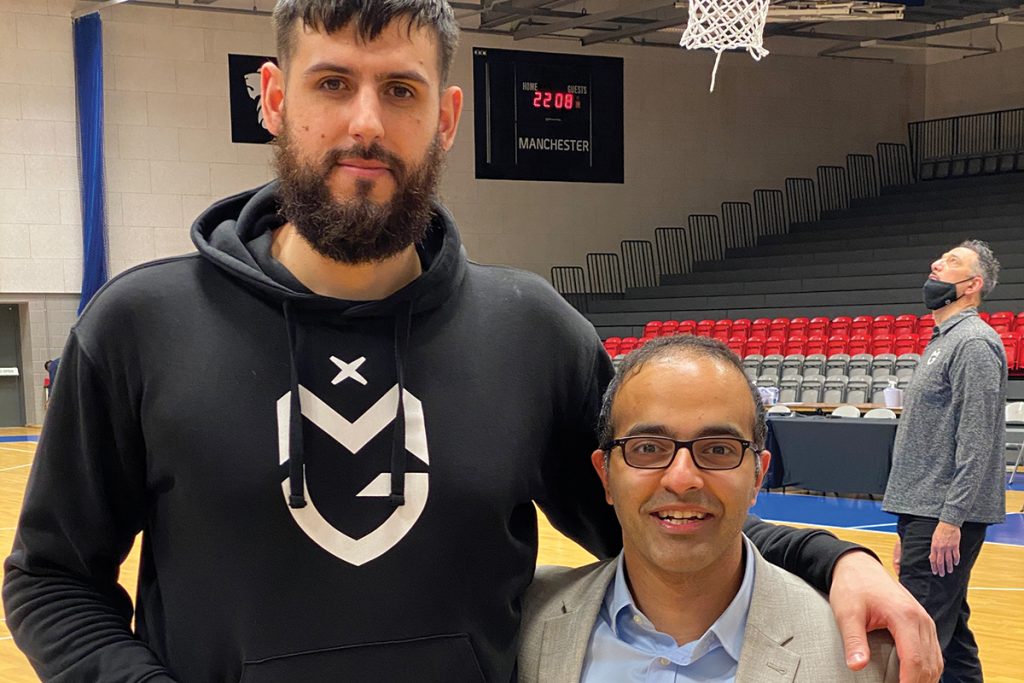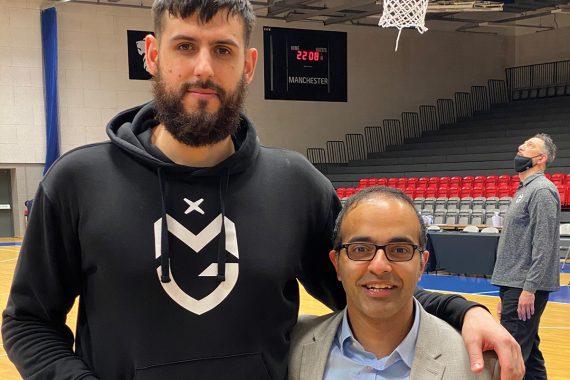
Manchester GP Dr Haider Ali on being a basketball team doctor now that games have restarted
08.00
It’s Monday morning. The basketball performance centre facility opens up. Centre staff organise the main hall for the team’s arrival, which is scheduled for 11am.
At this point, all staff have to undergo Covid screening. This involves general questions to ascertain their overall health, a temperature check and a lateral flow test.
I got involved with the British Basketball League (BBL) when the first lockdown was lifted. It is a men’s professional basketball league of 10 teams, representing the highest level of play in England and Scotland.
At the height of the pandemic, most sports were at a standstill. Slowly, as things restarted, professional and elite sports needed to Covid-proof their activities. Having long been involved in charity work, I volunteered my services to my local team, the Manchester Giants.
09.00
The support staff meet to discuss the athletes’ health. This usually means sharing new information that hasn’t been updated on the players’ records, perhaps injuries sustained during an away fixture.
I brief the team about the options available for these issues. My physiotherapist colleagues detail a plan of action. The soft tissue and rehab team and fitness specialist discuss how these will fit into the day ahead and coming weeks.
The strength and fitness coaches discuss what they need to do to aid the athletes. We also discuss ongoing ailments and what progress has been made, as well as potential referrals and imaging requests.
11.00
The team arrives and each player has their individual assessment. There are sports massage and therapies for the players. They also have the opportunity to ask me about new issues I’m not aware of. We perform concussion assessments for new players, those with confirmed concussions, and for everyone before a major tournament, to check they’re fit for playing (like an MOT).
12.00
The players go to one court and run through drills, simulating routines and plays for game situations.
They take breaks throughout, and there’s further input from the medical team as required.
The adjacent court is laid out as a field hospital, with examination beds, massage beds and areas for one-to-one sessions with various health staff.
14.00
It’s time for a debrief with support staff, while the medical staff review the individual players after their training has finished.
At this point, we break away until 7pm, when it will be time for the second practice.
18.30
Waiting for the players to return, the medical staff reconvene, discuss the players, prepare the courts for game drills and continue rehab with any of the athletes who have an injury.
21.00
Practice ends with another debrief and individual assessments as required.
Reflecting on today, I consider how I find the weekend sessions more exciting. They’re not only lighter in terms of workload, they also allow me to relive my competitive days as a former university basketball player, when I join in some drills and even play against some of the players in shootouts and matches. At times, I surprise myself that despite my sedentary full-time GP job, I can still hold my own.
Working with the BBL and Manchester Giants has been a great opportunity for general practice and elite sport to collaborate for the wellbeing of both the community and elite athletes. There are a variety of projects in the pipeline for the future, with the aim of promoting health through sport, and I’m looking forward to being instrumental in their delivery.
I’ve also recently been in Dubai working on a project about sports as a means to deal with mental health issues.
Profile: Dr Haider Ali
Location
Central Manchester
Roles
Clinical GP with a special interest in medical dermatology; provider of managerial support and community coordination to staff in an inner-city PCN; sports doctor for teams including the Manchester Giants
Hours worked per week
Full days Monday to Thursday
Pulse July survey
Take our July 2025 survey to potentially win £1.000 worth of tokens

Visit Pulse Reference for details on 140 symptoms, including easily searchable symptoms and categories, offering you a free platform to check symptoms and receive potential diagnoses during consultations.
Related Articles
READERS' COMMENTS [1]
Please note, only GPs are permitted to add comments to articles












Nice to see this article from a fellow BBL doctor. My sister and I are currently GPs and team doctors for the Glasgow Rocks in the BBL. We got into this following resumption of play post-lockdown in 2020/21 , seeing an entire season behind closed doors with covid-measures in place, and a subsequent season which was played in front of spectators again. Fortunately the basketball tends to be less onerous than ice hockey; we are the team doctors for the Glasgow Clan EIHL team. We see many types and degrees of injury – sometimes sickening – on the ice every season but it still remains one of our most enjoyable roles. We will be sorry to leave this when we relocate to Canada in 2023 for a better lifestyle and work-life balance. I’d encourage any GP to consider volunteering to help with your local teams – even just be registering players and their families to allow you to undertake routine healthcare for them behind the scenes.